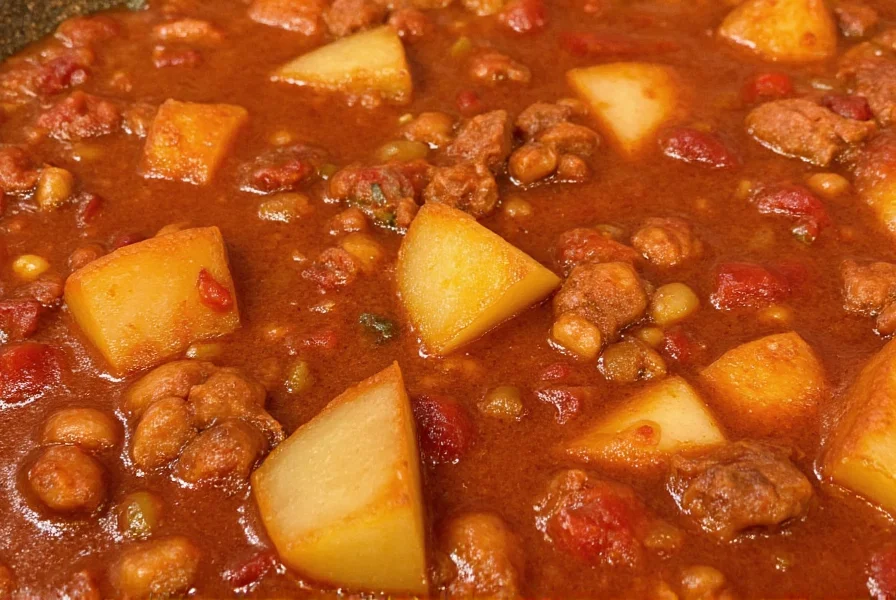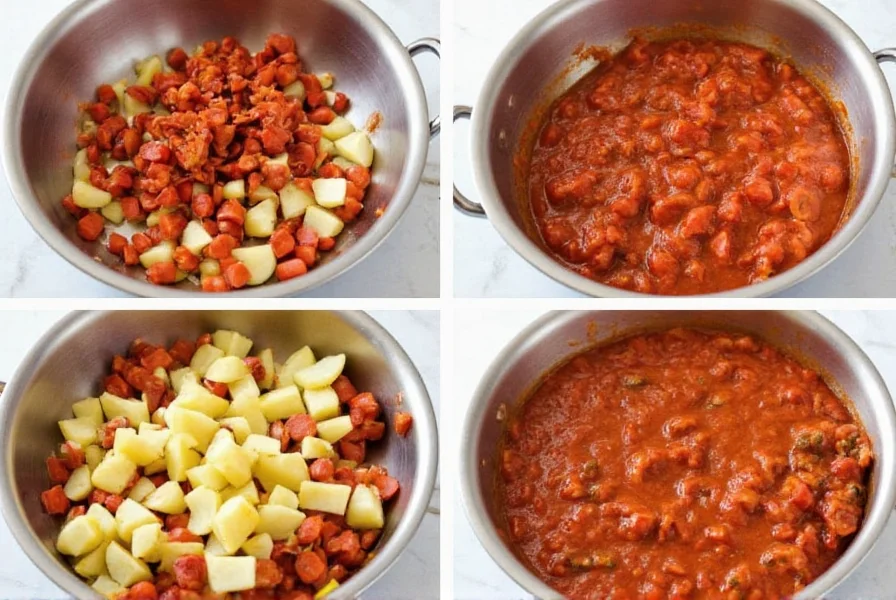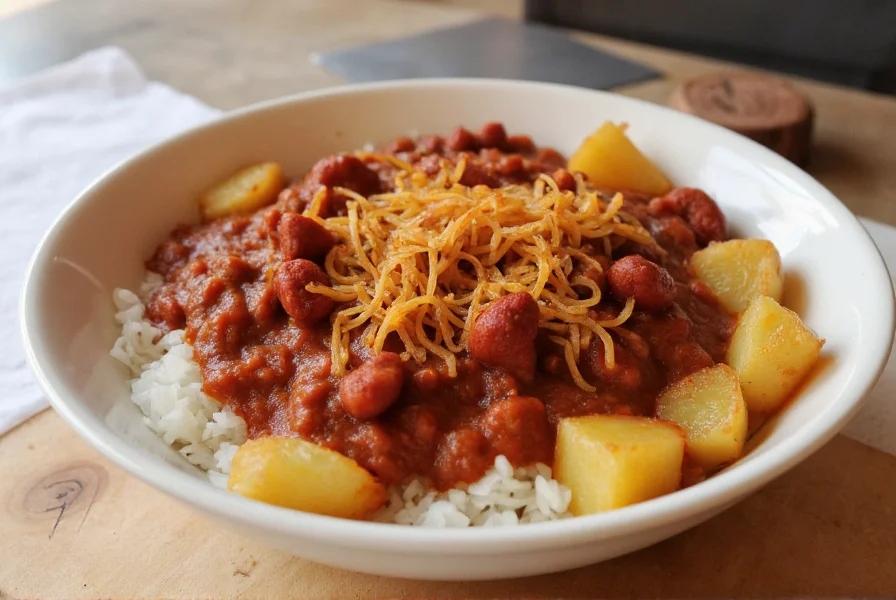For centuries, chili and potatoes have formed a powerful culinary partnership across various cultures. While chili con carne originated in Mexico and Texas, the addition of potatoes became popular as the dish spread northward, adapting to local ingredients and preferences. This pairing isn't just traditional—it's scientifically sound. Potatoes contain resistant starch that complements the protein in chili, creating a more balanced nutritional profile while enhancing satiety.
The Science Behind This Perfect Pairing
Understanding why chili and potatoes work so well together requires examining their complementary properties. Potatoes serve as flavor carriers due to their neutral taste and porous structure, soaking up the complex spices in chili while maintaining their own distinct texture. The potassium in potatoes balances the sodium typically found in chili, creating a more nutritionally harmonious meal.
When preparing chili with potatoes, timing matters significantly. Adding potatoes too early can cause them to disintegrate, while adding them too late leaves them undercooked. For optimal results, introduce diced potatoes during the last 20-25 minutes of cooking, allowing them to absorb flavors while maintaining their structure.
Best Potato Varieties for Chili
| Potato Type | Texture Characteristics | Best For | Cooking Time in Chili |
|---|---|---|---|
| Russet | Fluffy when cooked | Thick, hearty chili | 20-25 minutes |
| Yukon Gold | Creamy, holds shape well | Classic chili recipes | 18-22 minutes |
| Red Potatoes | Firm, waxy texture | Cold-weather chili | 25-30 minutes |
| Sweet Potatoes | Sweet, dense flesh | Vegan/vegetarian chili | 22-26 minutes |
Traditional Preparation Methods
Authentic chili and potatoes preparation varies by region but follows several consistent principles. In Texas-style chili, potatoes are often roasted separately and added as a topping, preserving their texture. New Mexico variations frequently incorporate potatoes directly into the chili during the final simmering stage. For the best results when making chili with potatoes, consider these professional techniques:
- Parboil potatoes for 5 minutes before adding to chili for more consistent cooking
- Use waxy potato varieties if you prefer distinct potato pieces in your finished dish
- Add potatoes cut slightly larger than other vegetables to account for differential cooking rates
- Season potatoes separately before adding to chili to enhance their individual flavor profile

Nutritional Synergy
The nutritional benefits of chili and potatoes extend beyond simple comfort food satisfaction. This combination provides complete protein when using beans in the chili, as the amino acids in beans complement those in potatoes. The vitamin C in potatoes enhances iron absorption from the chili's meat or beans, making this pairing particularly beneficial for iron uptake.
A standard serving of chili with potatoes delivers approximately 350-450 calories, with balanced macronutrients: 20-25g protein, 50-65g carbohydrates, and 10-15g fat. The fiber content typically ranges from 10-15g per serving, supporting digestive health and sustained energy release. For those monitoring sodium intake, using low-sodium broth and fresh ingredients can reduce sodium content by up to 40% compared to traditional recipes.
Common Mistakes to Avoid
Many home cooks make critical errors when preparing chili with potatoes that compromise the final dish. Overcooking represents the most frequent issue, resulting in potatoes that disintegrate and thicken the chili excessively. Using the wrong potato variety for your cooking method creates texture problems—starchy potatoes like Russets work well for chunky chili but break down in slow-cooked versions.
Another common mistake involves seasoning. Potatoes require their own seasoning separate from the chili base. Adding potatoes to already well-seasoned chili without additional salt for the potatoes themselves results in bland potato pieces. For optimal flavor integration, toss diced potatoes with 1/4 teaspoon salt per pound before adding them to the chili.

Variations Across Cultures
While American chili traditions dominate popular perception, chili and potatoes appear in diverse culinary traditions worldwide. In Peru, papa a la huancaina incorporates chili peppers with potatoes in a creamy cheese sauce. Korean cuisine features budae jjigae (army stew), which often includes potatoes alongside chili-spiced broth and various meats.
For authentic regional variations, consider these approaches:
- Southwestern style: Add roasted sweet potatoes and green chilies
- Texas-style: Use russet potatoes as a separate component rather than cooking in the chili
- Vegetarian version: Substitute sweet potatoes for regular potatoes with smoked paprika
- Campfire method: Wrap potato chunks in foil with chili ingredients for slow cooking
Serving Suggestions and Pairings
The versatility of chili and potatoes extends to serving options. For casual meals, serve in deep bowls with cornbread on the side. For more formal presentations, layer chili and potatoes in individual ramekins with cheese topping. The acidity of tomatoes in chili balances beautifully with the starchiness of potatoes, creating a natural harmony that requires minimal additional accompaniments.
Consider these pairing options to enhance your chili and potatoes experience:
- Fresh cilantro and lime wedges for brightness
- Avocado slices to add creaminess
- Radish slices for crunch and color contrast
- Warm tortillas for scooping
Frequently Asked Questions
Can I use frozen potatoes in chili?
Yes, but with caveats. Frozen diced potatoes work best in slow-cooked chili where texture matters less. For optimal results, thaw frozen potatoes completely and pat dry before adding to chili. Expect slightly softer texture than fresh potatoes, so add them during the last 15 minutes of cooking to prevent disintegration.
How do I prevent potatoes from getting mushy in chili?
Add waxy potato varieties like Yukon Gold or red potatoes, cut slightly larger than other ingredients. Parboil potatoes for 5 minutes first, then add during the last 20 minutes of cooking. Avoid stirring vigorously after adding potatoes, and maintain a gentle simmer rather than a rolling boil to preserve texture.
What's the best way to store leftover chili with potatoes?
Store chili with potatoes in an airtight container in the refrigerator for up to 4 days. The potatoes will continue absorbing liquid, so you may need to add broth when reheating. For longer storage, freeze portions without potatoes and add fresh potatoes when reheating for best texture. Frozen chili (without potatoes) maintains quality for 3-4 months.
Can I make chili with potatoes in an Instant Pot?
Absolutely. For best results in an Instant Pot, use the sauté function to brown meat first, then add all ingredients except potatoes. Pressure cook for 15 minutes, then quick release. Add diced potatoes and use the slow cook function for 20-25 minutes until potatoes reach desired tenderness. This method prevents potatoes from becoming waterlogged while ensuring proper cooking.
Are chili and potatoes a complete protein source?
When prepared with beans, chili and potatoes form a complete protein. The amino acids in beans complement those in potatoes, creating all nine essential amino acids your body needs. For meat-based chili, the meat provides complete protein on its own, with potatoes adding additional protein and complex carbohydrates for balanced nutrition.











 浙公网安备
33010002000092号
浙公网安备
33010002000092号 浙B2-20120091-4
浙B2-20120091-4